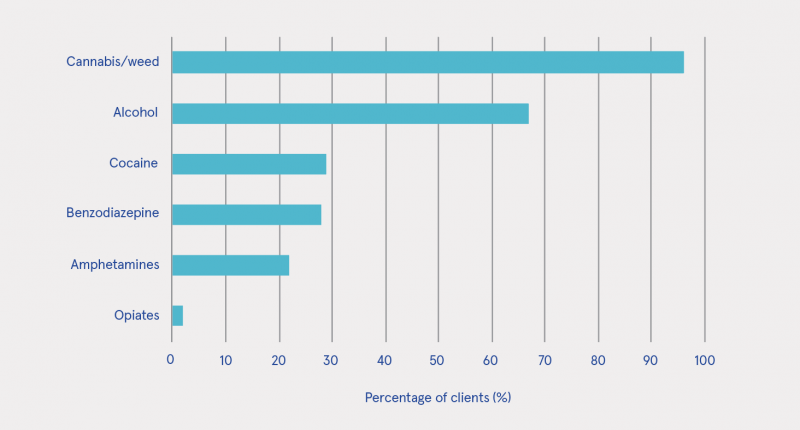Millar, Sean (2020) Adolescent Addiction Service report, 2020. Drugnet Ireland, Issue 75, Autumn 2020, p. 23.
| Preview | Title | Contact |
|---|---|---|
|
PDF (Drugnet 75)
590kB |
The Adolescent Addiction Service (AAS) of the Health Service Executive (HSE) provides support and treatment in relation to alcohol and drug use for young people and families from the Dublin suburbs of Ballyfermot, Clondalkin, Palmerstown, Lucan, and Inchicore. Services provided include advice, assessment, counselling, family therapy, professional consultations, and medications if required. In 2020, AAS published a report detailing referrals for 2019.1
Referrals
In 2019, AAS worked with 49 young people and their families, with a mean age of 15.3 years (range: 13–18 years). This figure includes new referrals, re-referrals, and continuances. The majority (90%) were male and 12% were non-Irish nationals. In terms of referral areas, the greatest numbers of referrals were from Clondalkin followed by Lucan, Ballyfermot, Palmerstown, and Inchicore.
Drug and alcohol use
Cannabis (weed) continued to be the main substance used by clients at 96%, while alcohol use was at 67% (see Figure 1). Other substances of use included cocaine (29%), benzodiazepines (28%), amphetamines (22%), and opiates (2%). Solvents and head-shop-type products did not feature among young people’s substance use in 2019. The report noted that the biggest change concerning secondary drug use related to increases in benzodiazepine use by 16% as well as the introduction of ‘eatables’, i.e. edibles. There were decreases in amphetamine use by 8% and cocaine by 7% compared with 2018.
Figure 1: Main substances used by AAS clients, 2019

Source: HSE AAS (2020)
Other issues
Other issues that presented related to absconding, indebtedness, and holding, distributing or dealing drugs. The service submitted child protection notifications and also held interagency meetings in relation to 10 young people. Of those who exited treatment, 62% had a planned discharge, 33% declined further treatment, and 5% moved out of the community or returned to the community of origin. The majority of young people (94%) were seen by a family therapist only, with 6% having a psychiatric assessment and 4% prescribed medication.
Conclusions
The report authors noted that, as in previous years, most young people had established patterns of substance use prior to referral and, as a consequence, some struggle to maintain a drug-free status. Nevertheless, most achieve stability and several remain abstinent. They concluded that there is a need for parents and non-parental adults to identify young people within risk groups at an early stage and to elevate concern for them.
- Adolescent Addiction Service (2020) Adolescent Addiction Service report 2020. Dublin: Health Service Executive. https://www.drugsandalcohol.ie/31890/
J Health care, prevention, harm reduction and treatment > Treatment and maintenance > Treatment factors
J Health care, prevention, harm reduction and treatment > Health care programme, service or facility
T Demographic characteristics > Adolescent / youth (teenager / young person)
VA Geographic area > Europe > Ireland
Repository Staff Only: item control page